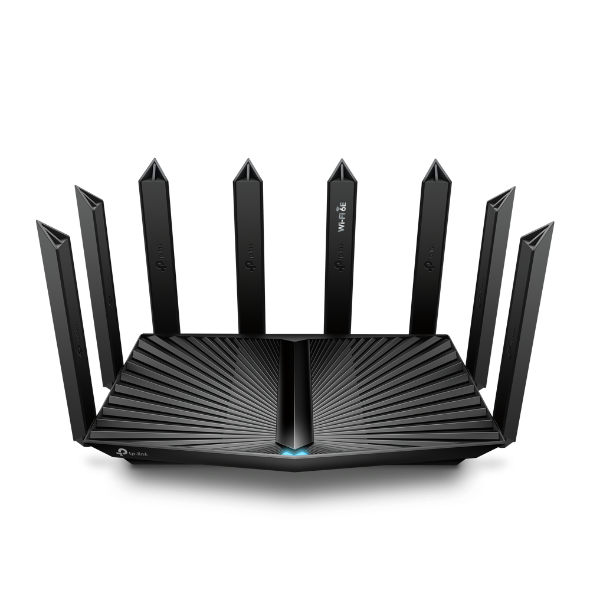What’s WiFi 6E?
Simply put, WiFi 6E means WiFi 6 extended to the 6 GHz band. WiFi 6E works with the same standard as WiFi 6 but with an extended spectrum. 6 GHz is the new frequency band ranging from 5.925 GHz to 7.125 GHz, allowing up to 1,200 MHz of additional spectrum. Unlike the existing bands on which channels are currently crammed into the limited spectrum, 6 GHz band exists without overlap or interference. Access to the 6 GHz frequency brings more bandwidth, faster speeds, and lower latency, opening up resources for future innovations like in AR/VR, 8K streaming and more.
*WiFi 6 is the next-gen standard in WiFi technology, also known as “AX WiFi” or “802.11ax WiFi”.
Learn more about WiFi 6

Note: The FCC opened up 1200 MHz of spectrum in the 6 GHz band, paving the way for Wi-Fi 6E in the US. The European Union has opened up 480 MHz spectrum in the 6 GHz band (ranging from 5.945 GHz to 6.425 GHz) for the implementation of wireless access systems.
Why Do We Need the 6 GHz Band
-

Increasing Number
of WiFi Devices -

Heavier Traffic on WiFi
-

Overcrowding
on Original Bands -

Signal Interference From 2.4 GHz and 5 GHz
Minimize Network Interference
from Your Neighbor
How Will WiFi 6E Influence Daily Life
WiFi 6E utilizes the capabilities of 6 GHz to enable high-bandwidth applications that require faster data throughput such as high-definition video streaming and virtual reality, as well as lower latency connectivity for online gaming applications.
-
More spectrum,
lower latency -
Wider channels,
more throughput -
Congestion-free,
less interference
-
Warp Speeds for 8K Streaming
-
Online Gaming with No Lag
-
Ultra-Smooth VR/AR Experience
WiFi 6E Makes a Difference
-
Clean and Congestion-Free
Unlike the crowded 2.4 GHz and 5 GHz bands, the wide-open 6 GHz spectrum is occupied only by efficient WiFi 6 connections, removing frustrations currently caused by overcrowding on many WiFi networks. Channels on the newly opened 6 GHz band also wouldn’t overlap with each other, greatly reducing network congestion.
-
Wider Lanes for Faster Speeds
WiFi 6E allows for 7 additional 160 MHz channels that double bandwidth and throughput, enabling many more simultaneous transmissions at the highest possible speeds. This translates to users enjoying 8K movies, AR/VR gaming, and large file downloads—all without buffering.
2.4 GHz: does not allow 160 MHz channels
5 GHz: allow 2× 160 MHz channels
6 GHz: allow 7× 160 MHz channels
Note: Due to the regulations, The European Union has opened up 480 MHz (3× 160 MHz) spectrum in the 6 GHz band for the implementation of wireless access systems.

160 MHz channels
bring 2× bandwidth and 2× throughput
Improved Capacity with More Spectrum
WiFi 6E offers up to 1,200 MHz of additional spectrum for 6 GHz WiFi, fulfilling the needs of ever-increasing WiFi usage. The 1.2 GHz of contiguous spectrum more than doubles the number of pathways currently available for sending and receiving data, dramatically increasing network capacity while reducing congestion.
Note: Due to the regulations, The European Union has opened up 480 MHz (3×160 MHz) spectrum in the 6 GHz band for the implementation of wireless access systems.
7 X 160 MHz =1200 MHz
WiFi 6E: Unlock the Full Potential of WiFi 6
Opening the 6 GHz band will change the game for WiFi 6. WiFi 6 brings about upgraded performance in network efficiency and capacity. Whereas the advantages of WiFi 6 are not fully realized while competing with transmissions from WiFi 5 (or other radios). The 6 GHz band is available only for WiFi 6 traffic, allowing WiFi 6 to meet its intended potential.

More Efficient,
Higher PerformanceGreenfield 6 GHz spectrum

More Throughput,
Lower Latency6 GHz brings 160 MHz to life
How is WiFi 6E different from WiFi 4, WiFi 5 and WiFi 6
| Wi-Fi 4 | Wi-Fi 5 | Wi-Fi 6 | Wi-Fi 6E | |
|---|---|---|---|---|
| Launch date | 2007 | 2013 | 2019 | 2021 |
| IEEE standard | 802.11n | 802.11ac | 802.11ax | |
| Maximum data rate | 1.2 Gbps | 3.5 Gbps | 9.6 Gbps | |
| Bands | 2.4 GHz, 5 GHz | 5 GHz | 2.4 GHz, 5 GHz | 2.4 GHz, 5 GHz, 6 GHz |
| Security | WPA 2 | WPA 2 | WPA 3 | |
| Channel size | 20 MHz, 40 MHz | 20 MHz, 40 MHz, 80 MHz, (2×) 160 MHz | 20 MHz, 40 MHz, 80 MHz, (7×) 160 MHz* | |
| Modulation | 64-QAM | 256-QAM | 1024-QAM | |
| MIMO | 4x4 MIMO | 4x4 MIMO, DL MU-MIMO | 8x8 MU-MIMO | |
| Highlights | Introducing MIMO |
Introducing 160 MHz Channel Faster Speed with 5 GHz band |
4x More Capacity 1.25x Speed Improvement 4x Longer OFDM Symbol 160 MHz Channel Width OFDMA, 8x8 MU-MIMO |
Extended to the Latest 6 GHz Band Congestion-Free, Less Interference, and Lower Latency 7x 160 MHz Channels for More Spectrum* |
*The FCC opened up 1200 MHz (7× 160 MHz) of spectrum in the 6 GHz band, paving the way for Wi-Fi 6E in the US. The European Union has opened up 480 MHz (3× 160 MHz) spectrum in the 6 GHz band for the implementation of wireless access systems.
TP-Link Wi-Fi 6E Products
All Deco
High Gain Adapters
PCIe Adapters
All Wi-Fi Routers
-
 New
NewArcher GXE75
AXE5400 Tri-Band Wi-Fi 6E Gaming Router
-
 New
NewArcher AXE200 Omni
AXE11000 Tri-Band Wi-Fi 6E Motor Router
-
 New
NewArcher AXE300
AXE16000 Quad-Band 16-Stream Wi-Fi 6E Router with Two 10G Ports
-
 New
NewArcher AXE95
AXE7800 Tri-Band Wi-Fi 6E Router
-
 New
NewArcher AXE75
AXE5400 Tri-Band Gigabit Wi-Fi 6E Router
-

Archer AXE5400
AXE5400 Tri-Band 6-Stream Wi-Fi 6E Router


_EU_1.0_Overview_1_normal_20220411032339n.png)





